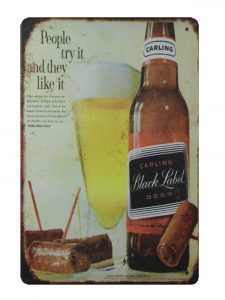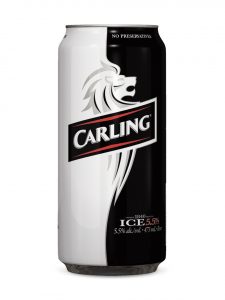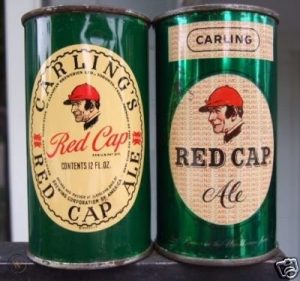13 Carling

Introduction:
The topic of this paper will be on the topic of beer, more importantly, Carling beer. This will go over some key elements as to what made Carling the beer we know of today, looking at where it has begun, how far it has come, and how it holds its status in today’s world of beer.

Origins:
Carling was originally created back in 1818 in Canada (London, Ontario) by a farmer who immigrated from the British county of Yorkshire by the name of Thomas Carling. He had a large property and had asked friends and Neighbours to help clear it for him, in return he provided them with his own brew of beer. With the success of them heavily enjoying the brew, he began to sell across Canada and with soldiers during that time (1840s) but he only saw enormous success by the 1870s where Carling would then become a household name. A few decades later, Thomas would hand the company over to his two sons William and John, before passing in 1911. Shortly after by the 1930s prohibition became prominent in Canada, and they then began to look at having a brewery in the U.S, and by 1934 they would then have their first brewhouse in Cleveland. Their main sellers during that time were the red cap ale and black label beers. By the 1950s they were looking at expanding even more and began selling to the UK and had a loyal following very quickly, which led to becoming one of Britain’s main beer sellers since 1980. Because of that great popularity, they have their main operations and brewing in Britain, using Britain’s farmers and products.

Key Milestones:
- 1818, the first creation of Carling was a success, leading into a genuine business as a small Canadian start-up.
- 1870, Carling became extraordinarily successful, becoming known as a household name in Canada
- 1934, Started new business across the border (Cleveland), allowing for more success in not only Canada but in the U.S. with two more styles of ale.
- 1950, started selling globally and quickly built a large following in the UK.
- 1980, became Britain’s number one beer and still holds that title 40 years later.
- Present-day, now primarily based in Britain.

Brewing Science & Industrialization:
As Thomas had been known as a very good homebrewer, he was still brewing during the time of the industrial revolution so he was limited to what he could use. For the longest time, he had just been using a very basic setup that he himself made with your basic ingredients (wheat, barley, etc), but it was until many years later he could open his first real brewery. He very strategically had his brewery across the street from the barracks for the troops at the time. It was not the largest by any means at the time, but ” the brewery consisted of two potash kettles and a horse to turn the grinding wheel” (Sneath, 2001). With this, he was able to produce much more beer to sell and was able to quickly hire about 6 employees to help him run his business.

Carling’s brewery in Baltimore, 1960’s
Beer Style:
As there are a few different types of Carling and have been over the years, they have all been somewhat different from one another, but they are still true to their original creation as a Lager. Currently, it consists of “Canadian barley malts and selected aroma and bittering hops” (Molson-Coors, 2022). Like most other companies in brewing, they tend not to stray too far from the original formula, and with Carling, they have just modernized their ways with arguable cleaner ingredients and more efficient brewing properties with their upgraded equipment. It did not become Britain’s number one beer out of coincidences, as this lager is a thing of beauty.
WWI/WWII Era:
In 1930, Carling had joined BCO (Brewing Corporation of Ontario) to which they “launched Carling in the US in 1932 through a joint venture” (Wikipedia, 2022). This saw quick success as shortly after in 1934 they had bought O’keefe brewery. Carling was doing fairly well over the course of WWII, as only about 10% of breweries in the US were hit hard enough to shut down due to war efforts, whereas Europe saw a loss of about 70%. A few years later the BCO had turned into Canadian Breweries (CBL) and assisted in Carling’s growing exponentially, as it allowed Carling to purchase numerous other breweries in Canada, soon turning the brand into a Canadian National brand.

Ad for Carling, 1940’s
Knowledge Checks:
References (APA):
Home. Carling. (n.d.). Retrieved February 6, 2022, from https://www.carling.com/
Carling Beer. Natick Historical Society. (n.d.). Retrieved February 6, 2022, from https://www.natickhistoricalsociety.org/carling-beer
Carling – History. (n.d.). Retrieved February 6, 2022, from https://www.liquisearch.com/carling/history
Sneath, A. W. (2008). Brewed in Canada: The untold story of canada’s 350-year-old brewing industry. Dundurn Press.
Carling – Canada. Carling | Molson Coors. (n.d.). Retrieved March 13, 2022, from https://www.molsoncoors.com/brands/our-brands/carling?region=931
Wikimedia Foundation. (2022, March 10). Carling Brewery. Wikipedia. Retrieved March 13, 2022, from https://en.wikipedia.org/wiki/Carling_Brewery

